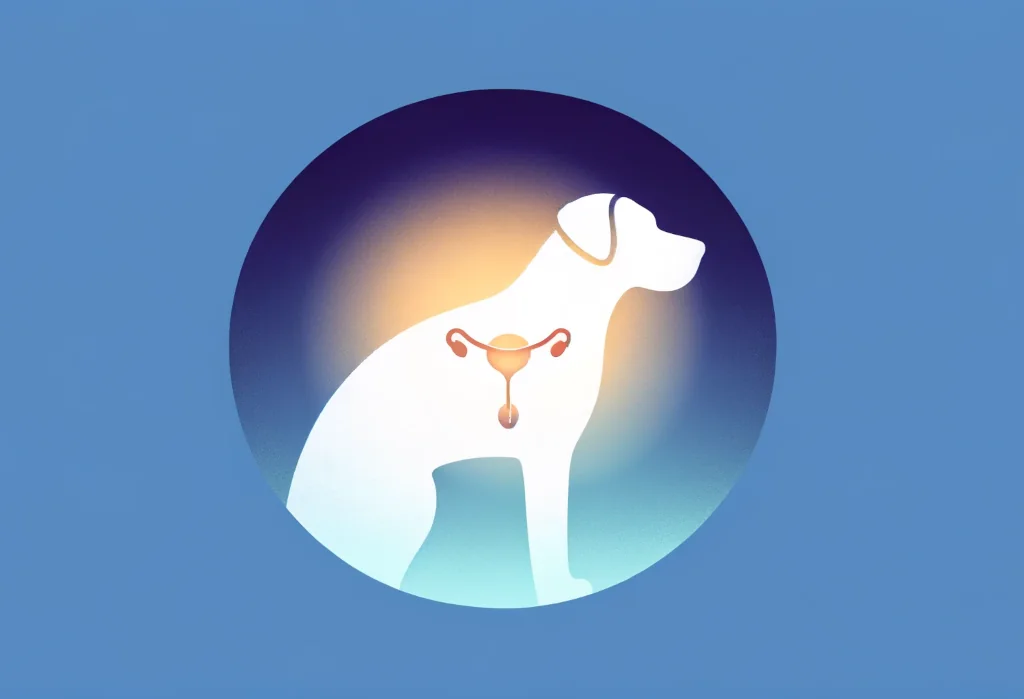Discovering your four-legged friend is showing signs of discomfort can throw any pet owner into a whirlwind of worry. Especially when it comes to urinary tract infections (UTI), which have your pup going round in circles, literally.
In this guide, you’ll learn everything there is to know about treating UTIs in dogs – turning those worried whimpers back into wagging tails.

Quick Takeaways:
- Watch for signs like increased urination, difficulty urinating, or blood in urine as early indicators of UTIs in dogs.
- Consulting your vet for diagnosis and treatment, which may include antibiotics and dietary changes, is crucial for recovery.
- Prevent UTIs with strategies such as ensuring proper hydration, regular potty breaks, and maintaining good hygiene.
What Causes UTIs in Dogs?
Urinary Tract Infections (UTIs) in dogs can leave your furry friend feeling pretty miserable. But what exactly kicks off this unpleasant experience? The primary culprit is usually bacteria that enter and multiply in the urinary tract, sparking an infection. However, it’s not just a game of “bad luck” or “dirty environments.” Several factors can contribute to making your dog susceptible to UTIs.
- Underlying Health Issues: Conditions like diabetes, bladder stones, or abnormalities in the anatomy of the urinary tract can put dogs at a higher risk of developing infections.
- Weakened Immune Systems: Dogs with weakened immune systems, either due to age, medication, or other health issues, might have a harder time fighting off the bacterial invaders.
- Use of Catheters: For dogs that require catheterization during medical treatments, the risk of UTIs might increase due to the direct pathway it provides for bacteria to enter.
Understanding these triggers is crucial not only for treating current infections but for preventing future episodes. Now, let’s talk about what signs might indicate your dog is dealing with a UTI.
Recognizing the Signs: Does My Dog Have a UTI?
Spotting a UTI early can make a huge difference in how comfortably and quickly your dog recovers. Here are some red flags that might suggest a trip to the vet is in order:
- Increased Urination: If your dog is asking to go out more often or has accidents inside, take note.
- Pain or Difficulty Urinating: Whining, hesitating, or frequently attempting to urinate with little to no output is a clear sign of distress.
- Blood in Urine: Always a signal that something’s not right, if the urine appears pinkish or has visible streaks of blood, it’s time to act.
- Lethargy or Irritability: If your dog just isn’t themselves, seeming more tired or snappy, particularly in conjunction with other symptoms, it could be a UTI.
How Are UTIs in Dogs Diagnosed?
Diagnosing a UTI in dogs involves a few steps, but rest assured, it’s all pretty straightforward. When you take your furry friend to the vet, here’s what you can expect:
-
Detailed History Taking : Your vet will chat with you about the symptoms you’ve noticed, any recent changes in behavior or diet, and your dog’s medical history. This conversation helps narrow down potential causes.
-
Physical Examination : The vet will conduct a physical exam, which may include palpating (gently pressing) the abdomen to check for pain or swelling in the bladder area.
-
Urinalysis : This is the real diagnostic superstar. A urine sample will be taken to look for signs of infection, such as bacteria, white blood cells, or blood. This test can often confirm a UTI on the spot.
-
Further Tests : In cases where UTIs are recurrent or the cause isn’t straightforward, additional tests like X-rays, an ultrasound, or a urine culture might be recommended. These can help pinpoint underlying issues or identify the specific bacteria causing the infection.
A Unique Insight : An often-overlooked diagnostic gem is the assessment of your dog’s water intake and urination habits before symptoms arose. By comparing these, vets can sometimes gather additional clues about the UTI’s severity and nature, leading to a more tailored and effective treatment plan. So, keeping a simple journal of your dog’s normal water consumption and urination frequency can be incredibly useful during vet visits.
By understanding what causes UTIs, recognizing the signs, and knowing what to expect during diagnosis, you’re well-equipped to support your furry friend through these uncomfortable episodes. Remember, early detection and treatment are key to a swift recovery, so never hesitate to consult your vet if you suspect something’s amiss.
Treatment Options for Canine UTIs
When your furry friend is dealing with a urinary tract infection (UTI), seeing them in discomfort can be heartbreaking. The good news is that UTIs in dogs are quite manageable and treatable. From traditional antibiotics to natural remedies, the treatment landscape is diverse. However, it’s crucial to kick things off by emphasizing the golden rule: always follow your vet’s instructions. Let’s dive into the treatment options available:
Antibiotics: The most common treatment for UTIs is antibiotics. They’re effective and typically work fast to alleviate symptoms. The specific type of antibiotic, along with the dosage and duration, depends on the severity of the infection and the dog’s overall health. Remember, even if your pooch starts to show signs of improvement quickly, it’s important to complete the full course of antibiotics to ensure the infection is entirely knocked out.
Probiotics: Pairing antibiotics with probiotics can be a game-changer. Probiotics help restore the balance of good bacteria in your dog’s gut, which antibiotics can disrupt. This not only aids in digestion but also helps prevent future UTIs.
Increased Water Intake: Encouraging your dog to drink more water helps flush out bacteria from the urinary tract. Consider adding water to your dog’s food or investing in a pet water fountain to entice them to drink more.
Natural Remedies: For those looking for an alternative or addition to conventional treatment, certain natural remedies might offer relief. Cranberry supplements, for instance, can help prevent bacteria from adhering to the bladder walls, though they should not replace antibiotics. Always consult with your vet before introducing any new supplements to your dog’s diet.
A Combination Approach: Sometimes, a multi-faceted approach works best. This could mean blending antibiotics with dietary changes, supplements, and increased water intake. It’s about finding the right balance that suits your dog’s specific needs and ensuring a full recovery.
Remember, UTIs can vary in severity, and what works for one dog might not work for another. Following your vet’s guidance is key to navigating these waters successfully.
Prevention Tips: Keeping UTIs at Bay
Preventing UTIs is not just about dodging a bullet; it’s about ensuring your dog’s overall well-being and happiness. Incorporating a few strategic practices into your daily routine can make a huge difference. Here’s how you can keep those pesky UTIs at bay:
-
Hydration is Key: Make sure your dog has constant access to fresh, clean water. Proper hydration is essential for preventing urinary problems.
-
Regular Potty Breaks: Frequent urination can help flush out bacteria before it has a chance to cause an infection. Encourage your dog to go outside more often throughout the day.
-
Diet Matters: High-quality, balanced diets support urinary health. Some diets are specifically formulated to promote a healthy urinary tract. Discuss with your vet what’s best for your dog.
-
Keep It Clean: Regular grooming, especially for long-haired breeds, can prevent bacteria from entering the urinary tract. Pay special attention to hygiene in the genital area.
-
Stress Less: Believe it or not, stress can impact your dog’s urinary health. Ensure they have a calm environment, plenty of exercise, and mental stimulation.
-
Regular Vet Check-Ups: Regular wellness exams can help catch and prevent UTIs before they become a significant issue. It’s also a chance to discuss any concerns and get personalized prevention tips.
One often overlooked yet simple tip is to clean your dog’s water bowl daily. Bacteria thrive in stagnant, unclean water, so keeping the bowl clean can help prevent the ingestion of harmful bacteria.
By incorporating these prevention tips into your dog’s routine, you’re not just protecting them from UTIs; you’re enhancing their overall quality of life. Remember, when it comes to health, prevention is always better than cure. Now you’re equipped with the knowledge to both treat and prevent UTIs in dogs, ensuring your furry companion stays happy, healthy, and UTI-free.
Alex, a passionate animal lover, has experience in training and understanding animal behavior. As a proud pet parent to two dogs and three cats, he founded AnimalReport.net to share insights from animal experts and expand his knowledge of the animal kingdom.




